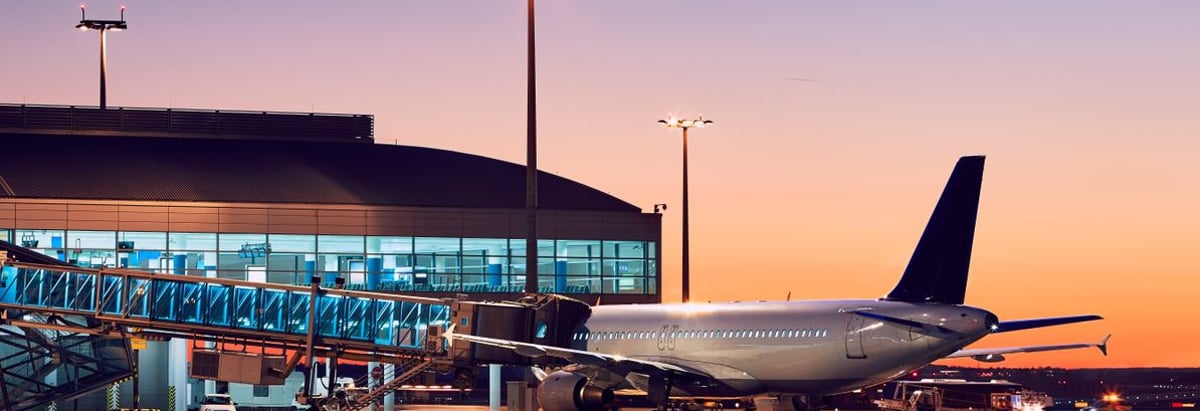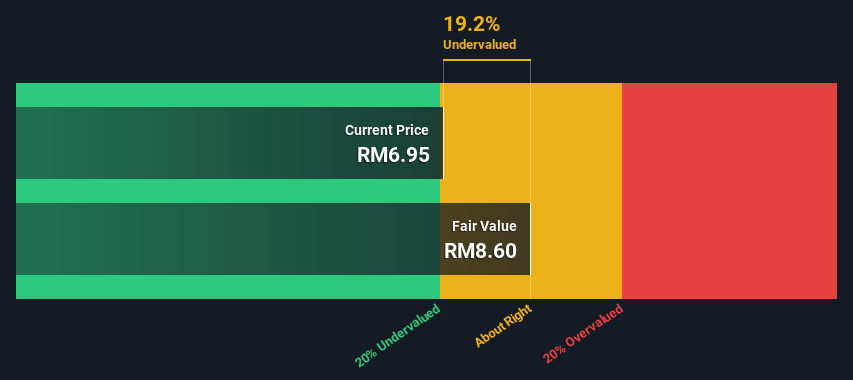- Malaysia
- /
- Infrastructure
- /
- KLSE:AIRPORT
Calculating The Intrinsic Value Of Malaysia Airports Holdings Berhad (KLSE:AIRPORT)

Key Insights
- Using the 2 Stage Free Cash Flow to Equity, Malaysia Airports Holdings Berhad fair value estimate is RM8.60
- With RM6.95 share price, Malaysia Airports Holdings Berhad appears to be trading close to its estimated fair value
- Our fair value estimate is 15% higher than Malaysia Airports Holdings Berhad's analyst price target of RM7.47
Does the April share price for Malaysia Airports Holdings Berhad (KLSE:AIRPORT) reflect what it's really worth? Today, we will estimate the stock's intrinsic value by projecting its future cash flows and then discounting them to today's value. We will take advantage of the Discounted Cash Flow (DCF) model for this purpose. It may sound complicated, but actually it is quite simple!
Remember though, that there are many ways to estimate a company's value, and a DCF is just one method. If you still have some burning questions about this type of valuation, take a look at the Simply Wall St analysis model.
View our latest analysis for Malaysia Airports Holdings Berhad
The Model
We're using the 2-stage growth model, which simply means we take in account two stages of company's growth. In the initial period the company may have a higher growth rate and the second stage is usually assumed to have a stable growth rate. To begin with, we have to get estimates of the next ten years of cash flows. Where possible we use analyst estimates, but when these aren't available we extrapolate the previous free cash flow (FCF) from the last estimate or reported value. We assume companies with shrinking free cash flow will slow their rate of shrinkage, and that companies with growing free cash flow will see their growth rate slow, over this period. We do this to reflect that growth tends to slow more in the early years than it does in later years.
A DCF is all about the idea that a dollar in the future is less valuable than a dollar today, and so the sum of these future cash flows is then discounted to today's value:
10-year free cash flow (FCF) estimate
| 2023 | 2024 | 2025 | 2026 | 2027 | 2028 | 2029 | 2030 | 2031 | 2032 | |
| Levered FCF (MYR, Millions) | RM919.5m | RM1.74b | RM1.68b | RM1.66b | RM1.66b | RM1.68b | RM1.72b | RM1.76b | RM1.81b | RM1.86b |
| Growth Rate Estimate Source | Analyst x5 | Analyst x8 | Analyst x5 | Est @ -1.21% | Est @ 0.22% | Est @ 1.23% | Est @ 1.93% | Est @ 2.42% | Est @ 2.77% | Est @ 3.01% |
| Present Value (MYR, Millions) Discounted @ 13% | RM812 | RM1.4k | RM1.2k | RM1.0k | RM893 | RM798 | RM719 | RM650 | RM590 | RM537 |
("Est" = FCF growth rate estimated by Simply Wall St)
Present Value of 10-year Cash Flow (PVCF) = RM8.5b
After calculating the present value of future cash flows in the initial 10-year period, we need to calculate the Terminal Value, which accounts for all future cash flows beyond the first stage. The Gordon Growth formula is used to calculate Terminal Value at a future annual growth rate equal to the 5-year average of the 10-year government bond yield of 3.6%. We discount the terminal cash flows to today's value at a cost of equity of 13%.
Terminal Value (TV)= FCF2032 × (1 + g) ÷ (r – g) = RM1.9b× (1 + 3.6%) ÷ (13%– 3.6%) = RM20b
Present Value of Terminal Value (PVTV)= TV / (1 + r)10= RM20b÷ ( 1 + 13%)10= RM5.8b
The total value is the sum of cash flows for the next ten years plus the discounted terminal value, which results in the Total Equity Value, which in this case is RM14b. To get the intrinsic value per share, we divide this by the total number of shares outstanding. Relative to the current share price of RM7.0, the company appears about fair value at a 19% discount to where the stock price trades currently. The assumptions in any calculation have a big impact on the valuation, so it is better to view this as a rough estimate, not precise down to the last cent.

Important Assumptions
We would point out that the most important inputs to a discounted cash flow are the discount rate and of course the actual cash flows. Part of investing is coming up with your own evaluation of a company's future performance, so try the calculation yourself and check your own assumptions. The DCF also does not consider the possible cyclicality of an industry, or a company's future capital requirements, so it does not give a full picture of a company's potential performance. Given that we are looking at Malaysia Airports Holdings Berhad as potential shareholders, the cost of equity is used as the discount rate, rather than the cost of capital (or weighted average cost of capital, WACC) which accounts for debt. In this calculation we've used 13%, which is based on a levered beta of 1.206. Beta is a measure of a stock's volatility, compared to the market as a whole. We get our beta from the industry average beta of globally comparable companies, with an imposed limit between 0.8 and 2.0, which is a reasonable range for a stable business.
SWOT Analysis for Malaysia Airports Holdings Berhad
- Debt is well covered by cash flow.
- Interest payments on debt are not well covered.
- Dividend is low compared to the top 25% of dividend payers in the Infrastructure market.
- Annual earnings are forecast to grow faster than the Malaysian market.
- Current share price is below our estimate of fair value.
- Revenue is forecast to grow slower than 20% per year.
Looking Ahead:
Although the valuation of a company is important, it is only one of many factors that you need to assess for a company. It's not possible to obtain a foolproof valuation with a DCF model. Rather it should be seen as a guide to "what assumptions need to be true for this stock to be under/overvalued?" If a company grows at a different rate, or if its cost of equity or risk free rate changes sharply, the output can look very different. For Malaysia Airports Holdings Berhad, there are three relevant items you should further research:
- Risks: For instance, we've identified 1 warning sign for Malaysia Airports Holdings Berhad that you should be aware of.
- Future Earnings: How does AIRPORT's growth rate compare to its peers and the wider market? Dig deeper into the analyst consensus number for the upcoming years by interacting with our free analyst growth expectation chart.
- Other Solid Businesses: Low debt, high returns on equity and good past performance are fundamental to a strong business. Why not explore our interactive list of stocks with solid business fundamentals to see if there are other companies you may not have considered!
PS. The Simply Wall St app conducts a discounted cash flow valuation for every stock on the KLSE every day. If you want to find the calculation for other stocks just search here.
New: Manage All Your Stock Portfolios in One Place
We've created the ultimate portfolio companion for stock investors, and it's free.
• Connect an unlimited number of Portfolios and see your total in one currency
• Be alerted to new Warning Signs or Risks via email or mobile
• Track the Fair Value of your stocks
Have feedback on this article? Concerned about the content? Get in touch with us directly. Alternatively, email editorial-team (at) simplywallst.com.
This article by Simply Wall St is general in nature. We provide commentary based on historical data and analyst forecasts only using an unbiased methodology and our articles are not intended to be financial advice. It does not constitute a recommendation to buy or sell any stock, and does not take account of your objectives, or your financial situation. We aim to bring you long-term focused analysis driven by fundamental data. Note that our analysis may not factor in the latest price-sensitive company announcements or qualitative material. Simply Wall St has no position in any stocks mentioned.
About KLSE:AIRPORT
Malaysia Airports Holdings Berhad
An investment holding company, engages in the development, management, operation, and maintenance of airports.
Solid track record with moderate growth potential.
Similar Companies
Market Insights
Community Narratives



